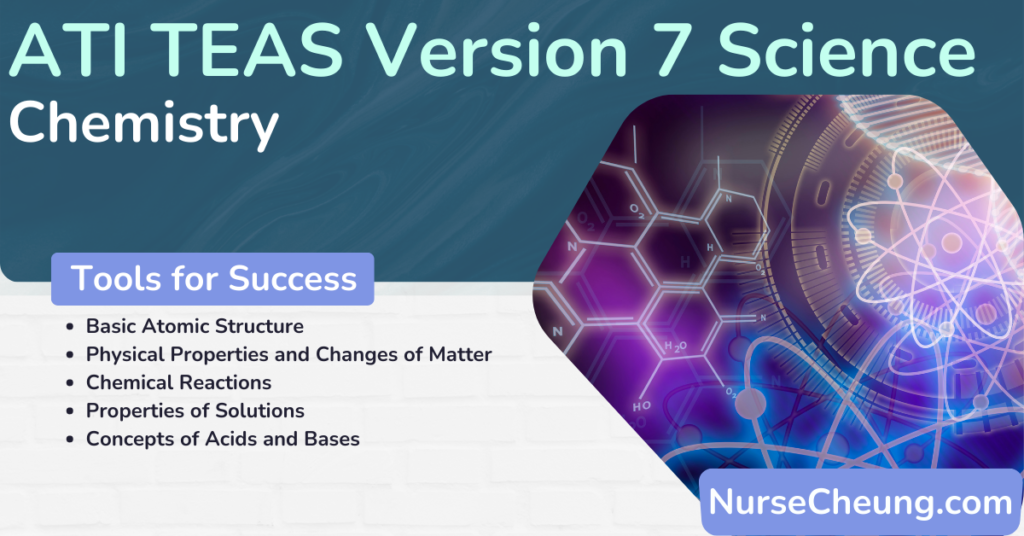The ATI TEAS Science exam is one of the most important tests that you will take to get into your academic career.
This test covers a variety of topics, including chemistry.
In this guide, we will provide an in-depth look at the chemistry section of the ATI TEAS Science exam.
We will discuss the types of questions that you will see on the test, and offer tips and strategies for how to best approach them.
Let’s get started!
Objectives for Chemistry
Total scored items on ATI TEAS: 8 questions out of 44
Recognize Basic Atomic Structure
Parts of an Atom
Atoms consist of structures within the nucleus containing protons and neutrons. Electrons orbit around the nucleus in shells.
A proton is a particle with a single positive charge, and a neutron is a particle with no electric charge.
An electron has a negative charge and is about 2000 times smaller than a proton.
The types of elements are determined by the number of protons within the nucleus. For example, carbon has 6 protons.
Isotopes are atoms of the same element that have a different number of neutrons.
For example, Carbon-12 and Carbon-14 are isotopes of carbon.
The atomic mass of an atom is the total number of protons and neutrons. As electrons are small their mass does not add to the mass of an atom.
The atomic mass is determined by adding the protons and neutrons together. For example, the atomic mass of Carbon-12 is 12 (the number of 6 protons + the number of 6 neutrons).
The atomic number is the number of protons in an atom.
Lastly, atoms can be positively charged, negatively charged, or neutral. This is determined by the number of protons in an atom.
If there are more electrons than protons, the atom will have a negative charge.
If there are more protons than electrons, the atom will have a positive charge.
If the number of protons and electrons are equal, then the atom is neutral.
Ions
Ions are atoms that have gained or lost protons, and as a result, have a charge either positive or negative. For example, traditionally sodium is made up of 11 protons, 12 neutrons, and 11 electrons. When sodium (Na) loses its one valence electron in its outermost shell, it becomes a cation with a charge of +.
- Cations are atoms that have lost one or more electrons and have a resulting positive charge.
- Anions are atoms that have gained one or more electrons and have a resulting negative charge.
When an atom gains electrons, it usually happens in the outermost shell.
For example, chlorine (Cl) has 17 protons, 18 neutrons, and 17 electrons. When chlorine (Cl) gains an electron, it becomes an anion with a charge of – .
Periodic Table of Elements
The periodic table of elements is a chart that shows how elements are related to one another.
The elements are organized by increasing atomic number. The columns of the periodic table are called groups, and the rows are called periods.
There are a few elements that do not fit perfectly into the periodic table. These are called transition elements or metalloids.
The first two rows of the periodic table (the alkali and alkaline earth metals) are considered the active metals.
The middle of the periodic table (the transition elements) are considered the reactive metals.
The elements in the far right column of the periodic table (the noble gases) are considered the inactive gases.
The types of elements are determined by the number of protons within the nucleus. The groups on the periodic table represent how many valence electrons are in an atom.
The columns on the periodic table go from left to right in order of increasing atomic number. The first column (group one) has one valence electron. The second column (group two) has two valence electrons, and so on.
The rows go from top to bottom in order of increasing atomic number. The first row (period one) has two valence electrons. The second row (period two) has eight valence electrons, and so on.
To identify the number of electrons and protons of an element, you must look at the integer shown on the periodic table. The integer is the element’s atomic number (which is shown as whole number without a decimal).
Atomic masses on the periodic table are shown as a decimal to account for the element’s various isotopes.
Orbitals are areas where electrons are likely to be found and are different to accommodate the different electron numbers.
- The s orbital is a spherical area surrounding the nucleus. This orbital has a max of two electrons at a time.
- The p orbital is a dumbbell-shaped area surrounding the nucleus. This orbital has a max of six electrons at a time.
- The d orbital is an hourglass-shaped area surrounding the nucleus. This orbital has a max of ten electrons at a time.
- The f orbital is an irregularly-shaped area surrounding the nucleus. This orbital has a max of fourteen electrons at a time.
The number of orbitals an element has is the same as the period number it’s in on the periodic table.
- The first period has one orbital, the second period has two orbitals, and so on.
- The orbitals are filled in order of increasing energy. The s orbital is always filled first, then the p orbital, and so on.
Valence electrons located in the outermost shell of an atom readily participate in chemical reactions. Elements are the most stable when they have a full valence shell.
Elements such as helium have full valence shells and are quite stable.
Other elements, such as sodium, have only one valence electron. These types of atoms are less stable and readily give up their valence electrons to achieve stability.
Ionic bonds are formed when atoms trade electrons in order to achieve stability. For example, when sodium (Na) and chlorine (Cl) form an ionic bond, Na gives up its one valence electron to Cl.
Covalent bonds are formed when atoms share electrons in order to achieve stability. For example, when two hydrogen (H) atoms form a covalent bond, they share their one valence electron.
In order to determine if a bond is ionic, covalent, or compound, you must look at the electronegativity of the atoms involved.
The electronegativity of an atom is a measure of how strongly it attracts electrons to itself.
The higher the electronegativity, the greater the atom’s attraction for electrons.
Atoms with high electronegativities (such as Cl) tend to form ionic bonds. Atoms with low electronegativities (such as H) tend to form covalent bonds.
Physical Properties and Changes of Matter
Physical Properties of Matter: Mass, Volume, and Density
Matter is anything that has mass and occupies space. Physical properties refer to the different properties of a substance that can change their state without changing the identity of the substance.
For example, water can exist in three states: solid, liquid, or gas. The states of matter are determined by the physical properties of the substance.
Mass is the amount of matter in an object. It is a measure of the inertia of an object and is measured in grams (g). For example, a paperclip has a mass of about 0.01 g.
Volume is the amount of space an object occupies and is measured in liters (L).
Density is the mass of an object divided by its volume. It is a measure of how much matter is packed into a given space and is measured in grams per liter (g/L).
The density of a substance can be affected by its temperature. For example, water has a density of 1000 kg/m^ at room temperature.
However, when water is heated, its density decreases and it expands.
When a substance changes state, its physical properties also change.
States of Matter
The most common states of matter are solid, liquid, gas, and plasma.
Solids have a definite shape and volume. They are the least compressible state of matter as molecules are packed together in a tight pattern.
Liquids have a definite volume but take the shape of their container. They are more compressible than solids as molecules are not packed together as tightly.
Gases have neither a definite shape nor volume. They are the most compressible state of matter as molecules are far apart from each other.
Plasma is a state of matter that is often found in the stars. It is a gas that is ionized, meaning that electrons have been stripped from the atoms.
The phase of a substance is dependent on two conditions: temperature and pressure.
Temperature is a measure of the average kinetic energy of the molecules in a substance. The higher the temperature, the more energy the molecules have (move particles of matter apart) and the more space they take up.
Pressure is a measure of the force exerted on an object by the surrounding atmosphere. The higher the pressure, the more the molecules are forced together.
The physical properties of a substance can be affected by changes in temperature and pressure. For example, water can exist in three states: solid, liquid, or gas. The state of water is determined by the temperature and pressure.
If the temperature is increased, the molecules of water will move faster and take up more space. This will cause the water to change from a solid to a liquid.
If the temperature is decreased, the molecules of water will move slower and take up less space. This will cause the water to change from a liquid to a solid.
If the pressure is increased, the molecules of water will be forced closer together. This will cause the water to change from a gas to a liquid.
If the pressure is decreased, the molecules of water will be forced further apart. This will cause the water to change from a liquid to a gas.
Changes Between States of Matter
Chemical properties of matter refer to the ability of a substance to change its identity. This can happen when the substance undergoes a chemical reaction.
These changes can include condensation, evaporation, sublimation, deposition, melting, and freezing.
- Condensation is the process of a gas changing to a liquid. This happens when the molecules of the gas slow down and become closer together.
- Evaporation is the process of a liquid changing to a gas. This happens when the molecules of the liquid gain enough energy to break away from the surface of the liquid.
- Sublimation is the process of a solid changing to a gas. This happens when the molecules of the solid gain enough energy to break away from the surface of the solid.
- Deposition is the process of a gas changing to a solid. This happens when the molecules of the gas slow down and become closer together.
- Melting is the process of a solid changing to a liquid. This happens when the molecules of the solid gain enough energy to break away from each other.
- Freezing is the process of a liquid changing to a solid. This happens when the molecules of the liquid lose enough energy to stay together.
The changes between states of matter are reversible. This means that the process can be reversed and the substance will change back to its original state.
For example, water can be evaporated and then condensed back to a liquid. Or, a substance can be melted and then frozen back to a solid.
Describe Chemical Reactions
Valence Electrons
In order to understand chemical reactions, it is important to know about valence electrons. Valence electrons are the electrons in the outermost energy level of an atom.
They are the electrons that are involved in chemical reactions. The number of valence electrons in an atom determines how it will react with other atoms.
Atoms can gain or lose valence electrons in order to achieve a full outer energy level. When this happens, the atom will form a chemical bond with another atom.
For example, when two chlorine atoms form a bond, each atom will have gained one valence electron. This is because chlorine has seven valence electrons.
Ionic and Covalent Bonds
There are two types of chemical bonds: ionic and covalent.
Ionic bonds are formed when atoms gain or lose valence electrons (take or giveaway).
Covalent bonds are formed when atoms share valence electrons.
Ionic bonds are usually formed between a metal and a non-metal. For example, sodium (Na) and chlorine (Cl) form an ionic bond.
Covalent bonds are usually formed between two non-metals. For example, carbon (C) and oxygen (O) form a covalent bond.
Chemical Reactions
Chemical reactions can be represented by chemical equations. Chemical equations are written using symbols and formulas. The symbols represent the elements in the reaction.
The formulas represent the compounds in the reaction (Reactants -> Products).
- The reactants are the substances that are involved in the reaction.
- The products are the new substances that are formed by the reaction.
For example, lets take a look at a combustion reaction.
Combustion is a type of reaction that happens when a substance reacts with oxygen (O) to form carbon dioxide (CO) and water (H).
The chemical equation for this reaction is:
C₆H₁₂O₆ (sugar) + 6O₂ (oxygen) -> 6CO₂ (carbon dioxide) + 2H₂O (water)
In this equation, C represents the element carbon, O represents the element oxygen, C₆H₁₂O₆ represents the compound sugar, 6O₂ represent the compound of oxygen, 6CO₂ represents the compound of carbon dioxide and 2H₂O represents the compound water.
The arrow in the equation means “reacts to form”. So, in this equation, the reactants are carbon and oxygen. The products are carbon dioxide and water.
Balancing Chemical Reactions
A chemical equation must be balanced. This means that there must be the same number of atoms of each element on both sides of the arrow.
For example, the equation for the combustion of methane (CH) is: CH₄ + 2O₂ -> CO₂ + 2H₂O
In order to balance this equation, we need to add a coefficient in front of each compound.
A coefficient is a number that is placed in front of a symbol or formula in order to multiply it.
Another example of balancing chemical reactions is the decomposition of water:
H₂O -> H₂ + O₂
In order to balance this equation, we need to add a coefficient of two in front of H₂O and H₂.
This is because there are two atoms of hydrogen (H) on the left side of the equation and two atoms of oxygen (O) on the right side of the equation.
Now that the equation is balanced, it looks like this:
2H₂O -> 2H₂ + O₂
Moles in Chemical Reactions
The mole is a unit that is used to measure the amount of a substance.
The mole can be used to measure the number of atoms, the number of molecules, or the mass of a substance.
The mole is used in chemical reactions because it allows us to calculate the amount of each substance that is needed in order to complete the reaction.
For example, lets say we want to know how many moles of oxygen we need in order to react with one mole of methane.
The equation for the combustion of methane is: CH₄ + O₂ -> CO₂ + H₂O
In this equation, we can see that for every one mole of methane (CH₄), we need one mole of oxygen (O₂).
This is because there are four atoms of carbon (C) in methane (CH₄) and for every one atom of carbon, we need two atoms of oxygen.
So, in order to react with one mole of methane, we need two moles of oxygen.
Demonstrate How Conditions Affect Chemical Reactions
Factors that Influence Reaction Rates
The rate of a chemical reaction is the speed at which the reactants are converted into products. Catalysts will speed up the reaction.
There are several factors that can influence the rate of a chemical reaction including endothermic reactions and exothermic reactions.
Endothermic reactions are reactions that absorb heat. The factor that influences the rate of endothermic reactions is the temperature.
- Higher temperatures will increase the rate of reaction because it provides the energy that is needed for the reaction to occur.
Exothermic reactions are reactions that release heat. The factor that influences the rate of exothermic reactions is the concentration of the reactants.
- Higher concentrations will increase the rate of reaction because there is a greater chance that the molecules will collide.
Chemical Equilibria
A chemical reaction is said to be at equilibrium when the rate of the forward reaction is equal to the rate of the reverse reaction.
At equilibrium, the concentrations of the reactants and products remain constant.
There are two types of equilibrium: dynamic equilibrium and static equilibrium.
- Dynamic equilibrium is when the forward and reverse reactions are occurring at the same time.
- Static equilibrium is when the concentrations of the reactants and products are not changing.
The position of equilibrium can be shifted by adding or removing reactants or products.
- If you add reactants, the position of equilibrium will shift to the right.
- If you remove reactants, the position of equilibrium will shift to the left.
Catalysts
A catalyst is a substance that increases the rate of a chemical reaction without being used up in the reaction.
Activation energy is the minimum amount of energy that is needed for a chemical reaction to occur.
Catalysts lower the activation energy by providing an alternative pathway for the reaction to occur.
For example, Enzymes are proteins that act as catalysts in biochemical reactions.
Enzymes are specific to the reaction that they catalyze and are usually named after the substrate that they act on.
Amylase is a enzyme catalyst that breaks down starch polymers and glucose monomers.
Understand Properties of Solutions
Polarity of Water
Water is a polar molecule. This means that the water molecules have a slight negative charge at the oxygen atom and a slight positive charge at the hydrogen atoms.
The polarity of water allows it to form hydrogen bonds with other molecules.
Hydrogen bonds are weak attractions between molecules.
Cohesion is the process of similar molecule surrounding and binding to another molecule.
- Water molecules can surround and bind to other molecules because of the polarity of water. Water attracts water.
Adhesion is the process of dissimilar molecules binding to another molecule.
- Water molecules can bind to other molecules because of the polarity of water. Water is consider the universal solvent, meaning there are many substances that can dissolve in water.
Solvents and Solutes
A solvent is a substance that dissolves in another substance.
- Water is the most universal solvent.
A solute is a substance that dissolves in a solvent.
- Sugar is the most common solute.
For example, a solution is formed when liquid mixes contains one or more solutes dissolve in a solvent.
Solutes can be classified as hydrophilic (water-loving) and hydrophobic (water-fearing).
An example of hydrophilic is salt and an example of hydrophobic is oil.
Solubility is the ability of a solute to dissolve in a solvent. The amount of solute that can dissolve in a given amount of solvent is called the solubility limit.
The solubility limit is dependent on the temperature.
For example, hot water can dissolve more sugar than cold water.
Concentration and Dilution of Solutions
The concentration of a solution is the amount of solute that is dissolved in a given amount of solvent.
Dilution is the process of adding solvent to a solution to decrease the concentration of the solution.
Different units of measure are used to express concentration of solutions depending on the application. The most common is molarity.
Molarity is a unit of measurement that describes the concentration of a solute in a solution. Molarity is expressed as moles of solute per liter of solution (mole of solute / liters of solution – mol/L).
Osmosis and Diffusion
Osmosis is the process of water molecules moving from an area of high water concentration to an area of low water concentration through a semi-permeable membrane.
A semi-permeable membrane is a barrier that allows some molecules to pass through but not others.
Diffusion is the process of molecules moving from an area of high concentration to an area of low concentration.
Osmosis and diffusion are both passive transport processes.
Passive transport processes do not require energy, they only require that the molecules be in motion.
An example of osmosis is when a plant takes in water from the soil through its roots.
An example of diffusion is when perfume molecules spread through a room.
Active transport is the process of molecules moving from an area of low concentration to an area of high concentration.
Active transport processes require energy because the molecules are moving against the concentration gradient.
An example of active transport is when a cell takes in glucose from the blood.
Describe Concepts of Acid and Bases
What are Acids and Bases?
An acid is a molecule that increases the concentration of hydrogen ions in a solution.
A base is a molecule that decreases the concentration of hydrogen ions in a solution.
pH
The strength of an acid or base is measured by the pH scale.
The pH scale ranges from 0 to 14.
A pH of 0 is the most acidic, a pH of 14 is the most basic, and a pH of 7 is neutral.
pH is a unit of measurement that describes the concentration of hydrogen ions in a solution.
The higher the concentration of hydrogen ions, the more acidic the solution.
The lower the concentration of hydrogen ions, the more basic the solution.
Buffers
A buffer is a solution that can resist changes in pH.
Buffers are important because they help maintain the pH of a solution within a certain range.
An example of a buffer is blood.
Blood has a pH of around 7.35 to 7.45, which is maintained by the buffer system.
The buffer system is made up of carbonic acid and bicarbonate.
- Carbonic acid is weak acid and bicarbonate is a weak base.
Together, they help maintain the pH of blood within a certain range.
Neutralization Reactions
A neutralization reaction is a chemical reaction between an acid and a base.
The products of a neutralization reaction are water and salt.
Neutralization reactions are important because they help maintain the pH of a solution within a certain range.
An example of a neutralization reaction is the reaction between stomach acid and antacid.
Stomach acid has a pH of around 0.75, which is too low.
Antacid has a pH of around 11, which is too high.
When stomach acid and antacid react, they neutralize each other and the pH of the solution is brought to a more neutral value.















